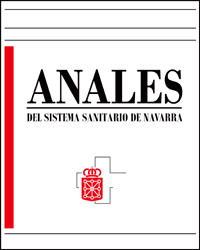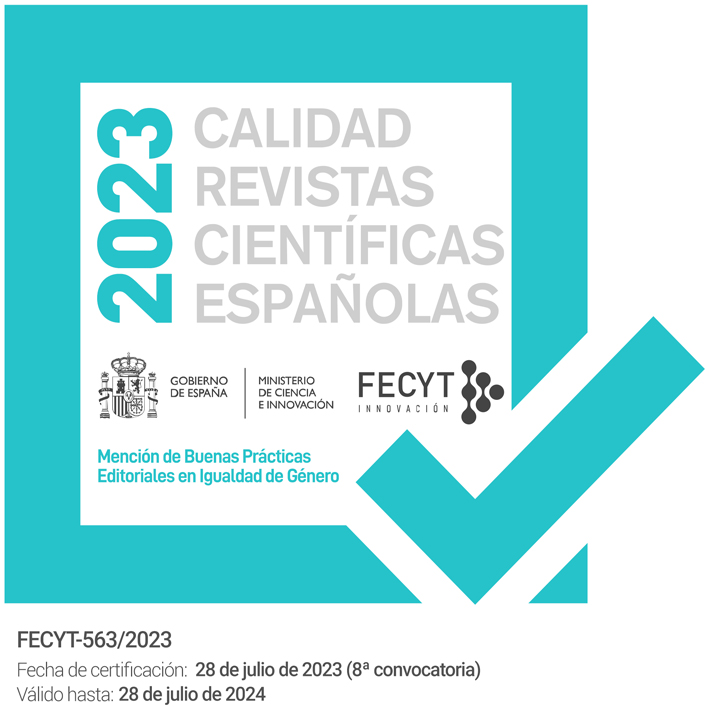Conocimientos y disposición para realizar soporte vital básico por agentes de la policía local
DOI:
https://doi.org/10.23938/ASSN.0033Palabras clave:
Policía. Reanimación Cardiopulmonar. Paro cardiaco Extrahospitalario. Actitud. Emergencias.Resumen
Fundamento. Determinar los conocimientos de los agentes de la policía local (PL) sobre la reanimación cardiopulmonar (RCP) y su disposición para realizarla, así como explorar la asociación entre la formación en RCP y estas variables.
Sujetos y método. Estudio descriptivo sobre una muestra de 390 agentes de la PL de Asturias (España). Se utilizó un cuestionario anónimo que midió nueve aspectos básicos sobre la RCP del Consejo Europeo de Reanimación y cuatro indicadores de la disposición para realizarla en situaciones reales. También se recogió información sobre la formación en RCP y su periodicidad, así como variables sociodemográficas y laborales básicas.
Resultados. El 19,7% de los PL no había recibido formación en RCP y el 36,4% la había recibido hacía más de dos. El 24,1% habían realizado al menos una RCP en situación real, de los cuales el 9,6% no estaba formado. Los aspectos de la RCP menos recordados fueron la profundidad (11%) y la frecuencia de las compresiones (24,4%). El 49,7% de los agentes se siente con suficiente preparación para realizar una RCP. Los conocimientos y la disposición se asociaron significativamente con haber realizado cursos de formación con una periodicidad menor de dos años.
Conclusiones. Dado que los agentes de PL deben intervenir con frecuencia en situaciones de parada cardiorrespiratoria como primeros intervinientes, la formación específica en RCP de los agentes de PL debería ser obligatoria y periódica, con al menos un curso cada dos años. Sería interesante determinar qué instrumentación didáctica es más eficiente para difundir estos cursos entre los policías.
Descargas
Citas
MONSIEURS KG, NOLAN JP, BOSSAERT LL, GREIF R, MACONOCHIE IK, NIKOLAOU NI et al. European resuscitation council guidelines for resuscitation 2015: Section 1. Executive summary. Resuscitation 2015; 95: 1-80.
GRÄSNER JT, LEFERING R, KOSTER RW, MASTERSON S, BÖTTIGER BW, HERLITZ J, et al. EuReCa ONE-27 Nations, ONE Europe, ONE Registry: A prospective one month analysis of out-of-hospital cardiac arrest outcomes in 27 countries in Europe. Resuscitation 2016; 105: 188-195.
DAYA MR, SCHMICKER RH, ZIVE DM, REA TD, NICHOL G, BUICK JE et al. Out-of-hospital cardiac arrest survival improving over time: Results from the Resuscitation Outcomes Consortium (ROC). Resuscitation 2015; 91: 108-115.
MARRUGAT J, ELOSUA R, MARTI H. Epidemiología de la cardiopatía isquémica en España: estimación del número de casos y de las tendencias entre 1997-2005. Rev Esp Cardiol 2002; 55: 337-346.
EISENBERG MS, BERGNER L, HALLSTROM A. Cardiac resuscitation in the community. Importance of rapid provision and implications for program planning. JAMA 1979; 241:1905-1907.
ONG ME, QUAH JL, HO AF, YAP S, EDWIN N, NG YY et al. National population based survey on the prevalence of first aid, cardiopulmonary resuscitation and automated external defibrillator skills in Singapore. Resuscitation 2013; 84:1633-1636.
SIPSMA K, STUBBS BA, PLORDE M. Training rates and willingness to perform CPR in King County, Washington: A community survey. Resuscitation 2011; 82: 564-567.
AXELSSON AB, HERLITZ J, HOLMBERG S, THORÉN AB. A nationwide survey of CPR training in Sweden: foreign born and unemployed are not reached by training programmes. Resuscitation 2006; 70: 90-97.
JENNINGS S, HARA TO, CAVANAGH B, BENNETT K. A national survey of prevalence of cardiopulmonary resuscitation training and knowledge of the emergency number in Ireland. Resuscitation 2009; 80: 1039-1042.
MARCO CA, LARKIN GL. Cardiopulmonary resuscitation: knowledge and opinions among the U.S. general public. State of the science-fiction. Resuscitation 2008; 79: 490-498.
BALLESTEROS-PEÑA S, FERNÁNDEZ-AEDO I, PÉREZ-URDIALES I, GARCÍA-AZPIAZU Z, UNANUE-ARZA S. Conocimientos y actitudes de los ciudadanos del País Vasco sobre la resucitación cardiopulmonar y los desfibriladores externos automatizados. Med Intensiva 2016; 40: 75-83.
FERNÁNDEZ-GUERRERO IM, BURBANO P, MARTÍN-SÁNCHEZ FJ, HIDALGO-RODRÍGUEZ A, LEAL-LOBATO MM, RIVILLA-DOCE C et al. Producción científica de los urgenciólogos españoles durante el quinquenio 2010-2014 y comparación con el quinquenio 2005-2009. Emergencias 2016; 28:153-166.
HUSAIN S, EISENBERG M. Police AED programs: a systematic review and meta-analysis. Resuscitation 2013; 84: 1184-1191.
SAYRE MR, EVANS J, WHITE LJ, BRENNAN TD. Providing automated external defibrillators to urban police officers in addition to a fire department rapid defibrillation program is not effective. Resuscitation 2005; 66: 189-196.
ROSAFIO T, CICHELLA C, VETRUGNO L, BALLONE E, ORLANDI P, SCESI M. Chain of survival: differences in early access and early CPR between policemen and high-school students. Resuscitation 2001; 49: 25-31.
WAALEWIJN RA, TIJSSEN JG, KOSTER RW. Bystander initiated actions in out-of-hospital cardiopulmonary resuscitation: results from the Amsterdam Resuscitation Study (ARRESUST). Resuscitation 2001; 50: 273-279.
WAALEWIJN RA, DE VOS R, KOSTER RW. Out-of-hospital cardiac arrests in Amsterdam and its surrounding areas: results from the Amsterdam resuscitation study (ARREST) in 'Utstein' style. Resuscitation 1998; 38: 157-167.
HIRSCH LM, WALLACE SK, LEARY M, TUCKER KD, BECKER LB, ABELLA BS. Automated external defibrillator availability and CPR training among state police agencies in the United States. Ann Emerg Med 2012; 60: 57-62.
MEDINA-ROBAINA DE, MEDINA-ROBAINA N, CABALLERO-ESTEVÉZ N, DOMÍNGUEZ-RODRÍGUEZ A. Conocimientos en soporte vital básico y desfibrilador externo semiautomático de los policías locales de una zona geográfica de España. Rev Esp Cardiol (Engl Ed) 2016; 69: 611-613.
DE VRIES W, VAN ALEM AP, DE VOS R, VAN OOSTROM J, KOSTER RW. Trained first-responders with an automated external defibrillator: how do they perform in real resuscitation attempts? Resuscitation 2005; 64: 157-161.
BERDEN HJ, BIERENS JJ, WILLEMS FF, HENDRICK JM, PIJLS NH, KNAPE JT. Resuscitation skills of lay public after recent training. Ann Emerg Med 1994; 23: 1003-1008.
PARRILLA RUIZ FM, CÁRDENAS CRUZ D, CÁRDENAS CRUZ A. Futuro de la metodología formativa en reanimación cardiopulmonar básica para población general. Aten Primaria 2013; 45: 175-176.
QUEIROGA AC, BARCALA-FURELOS R, ABELAIRAS-GÓMEZ C, FARTO-RAMÍREZ O, PRIETO-SABORIT JA, RODRÍGUEZ-NÚÑEZ A. Cardiopulmonary resuscitation quality among lifeguards: self-perception, knowledge, and performance. Am J Emerg Med 2014; 32: 1429-1430.
MIRÓ O. Elementos para mejorar la difusión de la reanimación cardiopulmonar entre la población lega. Aten Primaria 2013; 45: 544-545.
MIRÓ Ò, DÍAZ N, ESCALADA X, PÉREZ PUEYO FJ, SÁNCHEZ M. Revisión de las iniciativas llevadas a cabo en España para implementar la enseñanza de la reanimación cardiopulmonar básica en las escuelas. An Sist Sanit Navar 2012; 35: 477-486.
JORGE-SOTO C, ABELAIRAS-GÓMEZ C, BARCALA-FURELOS R, GREGORIO-GARCÍA C, PRIETO SABORIT JA, RODRÍGUEZ-NÚÑEZ A. Aprendizaje del uso del desfibrilador semiautomático mediante métodos audiovisuales en escolares. Emergencias 2016; 28: 103-108.
MIRÓ Ò, SÁNCHEZ M, JIMÉNEZ-FÁBREGA X, ESCALADA-ROIG X. Teaching basic life support in schools: still waiting for public funding. Resuscitation 2008; 77: 420-421.
ALDEEN AZ, HARTMAN ND, SEGURA A, PHULL A, SHAW DM, CHIAMPAS GT, COURTNEY DM. Video self-instruction for police officers in cardiopulmonary resuscitation and automated external defibrillators. Prehosp Disaster Med 2013; 28: 471-476.
Publicado
Cómo citar
Número
Sección
Licencia
Derechos de autor 2017 Anales del Sistema Sanitario de Navarra

Esta obra está bajo una licencia internacional Creative Commons Atribución-CompartirIgual 4.0.
La revista Anales del Sistema Sanitario de Navarra es publicada por el Departamento de Salud del Gobierno de Navarra (España), quien conserva los derechos patrimoniales (copyright ) sobre el artículo publicado y favorece y permite la difusión del mismo bajo licencia Creative Commons Reconocimiento-CompartirIgual 4.0 Internacional (CC BY-SA 4.0). Esta licencia permite copiar, usar, difundir, transmitir y exponer públicamente el artículo, siempre que siempre que se cite la autoría y la publicación inicial en Anales del Sistema Sanitario de Navarra, y se distinga la existencia de esta licencia de uso.








